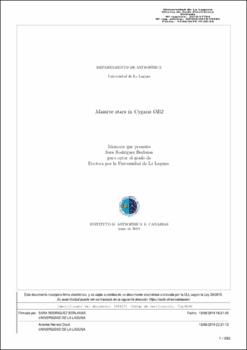Massive stars in cygnus ob2
Author
Rodr´ıguez Berlanas, SaraDate
2019Abstract
Esta tesis es un compendio de tres art´ıculos (m´as un cap´ıtulo adicional) donde
se recogen los frutos de un estudio enfocado en Cygnus OB2, una de las asociaciones de formaci´on estelar OB m´as cercana, masiva y joven de nuestra
Galaxia. Esta regi´on supone un excelente lugar donde estudiar las propiedades,
formaci´on y evoluci´on de estrellas masivas en un entorno de formaci´on estelar
muy activo. Nuestro objetivo principal es aumentar el conocimiento que existe actualmente de esta asociaci´on y su poblaci´on estelar. Para ello, hemos
llevado a cabo cuatro estudios diferentes (aunque relacionados) d´onde se han
caracterizado las principales propiedades f´ısicas de su poblaci´on masiva.
En primer lugar presentamos un estudio de membres´ıa en la regi´on de
Cygnus OB2 y sus alrededores con el fin de completar la poblaci´on de estrellas de tipo temprano conocida hasta el momento. Haciendo uso de nuevos
datos observacionales, hemos incrementado el n´umero de miembros OB de la
asociaci´on, a pesar de las limitaciones encontradas para obtener un censo completo. Adem´as, se ha investigado su distribuci´on de edad y extinci´on, as´ı como
una posible correlaci´on entre edad y longitud Gal´actica.
Dado que existen s´olidas indicaciones que apuntan a que muchas de las
estrellas masivas de Cygnus OB2 ya han explotado como supernova a lo largo
de su historia, hemos realizado un estudio qu´ımico de la asociaci´on con el
prop´osito de detectar posibles inhomogeneidades y comprobar si tambi´en existe
una correlaci´on entre composici´on qu´ımica y longitud Gal´actica que pudiera
evidenciar procesos de autoenriquecimiento.
Un problema persistente en estudios de estrellas masivas ha sido la poca
precisi´on en sus distancias. Afortunadamente, el sat´elite Gaia ha proporcionado recientemente astrometr´ıa precisa de un gran n´umero de estrellas masivas Gal´acticas, incluidas aquellas pertenecientes a Cygnus OB2. Por lo tanto,
hemos realizado un estudio de su estructura espacial interna, donde se ha cuantificado la subestructura observada a lo largo de la linea de visi´on mediante el
uso de inferencia Bayesiana y la creaci´on de un modelo parametrizado que
reproduce la distribuci´on de paralaje observada.
Finalmente, presentamos el censo espectrosc´opico m´as completo de estrellas O creado hasta el momento en Cygnus OB2. Se han identificado nuevos
sistemas binarios, y teniendo en cuenta los resultados derivados de los trabajos
anteriores, hemos realizado el an´alisis espectroscopico cuantitativo de todas las
estrellas aisladas. Se ha obtenido la distribuci´on de velocidad de rotaci´on y
derivado sus principales par´ametros espectrosc´opicos y f´ısicos. Para concluir,
se ha interpretado el estado evolutivo de la asociaci´on a partir del diagrama
Hertzsprung-Russell (HRD) y su an´alogo espectrosc´opico (sHRD). This thesis is a compendium of three published articles (plus an additional unpublished work) that represents the fruits of research focused on the massive
Cygnus OB2 star-forming region. It is one of the nearest, most massive and
youngest Galactic OB association and it provides an excellent target to study
massive star properties, formation and evolution in a very active environment.
Our main goal is to increase our current knowledge of the Cygnus OB2 association and its massive star population. With this aim, we have carried out
four different (but related) studies where the main physical properties of the
Cygnus OB2 massive population have been characterized.
Firstly, we present a membership study of Cygnus OB2 and its surroundings
for completing the currently known population of early-type stars in the region.
From new spectroscopic observations, we have increased the number of OB stars
known in the area in spite of the existing limitations for completing the whole
census. We also investigated the age and extinction distribution of the region,
and whether there exists a correlation between the observed age spread and
Galactic longitude.
Since there exist firm indications that many massive stars of Cygnus OB2
have exploded as supernovae during the history of the region, we include a
chemical analysis of a sample of OB stars in Cygnus OB2 for checking possible
inhomogeneities across the whole association and whether there also exists
a correlation of chemical composition with Galactic longitude that could be
caused by self-enrichment processes.
A persistent problem for massive star studies has been always the inaccuracy of their distances. Fortunately, the second data release of the Gaia satellite
has provided high-quality astrometry for a large number of Galactic massive
stars, including those in Cygnus OB2. Thus, a study of the spatial substructure
of the association is also included in this work, where we have quantified the
line-of-sight substructure within the association by using an inference approach
and creating a parametrized model that reproduces the observed parallax distribution.
Finally, we present the most complete spectroscopic census of O stars done
so far in Cygnus OB2. We have updated the binary fraction currently known
in the association, and taking into account the results derived in all previous
studies, we performed the quantitative spectroscopic analysis of all the isolated
stars. We obtained the distribution of rotational velocities and derived physical
and spectroscopic parameters, providing new temperature and gravity scales
for O-type stars. To conclude, we interpret the evolutionary status of the region
using the Hertzsprung-Russell diagram and its spectroscopic version.





